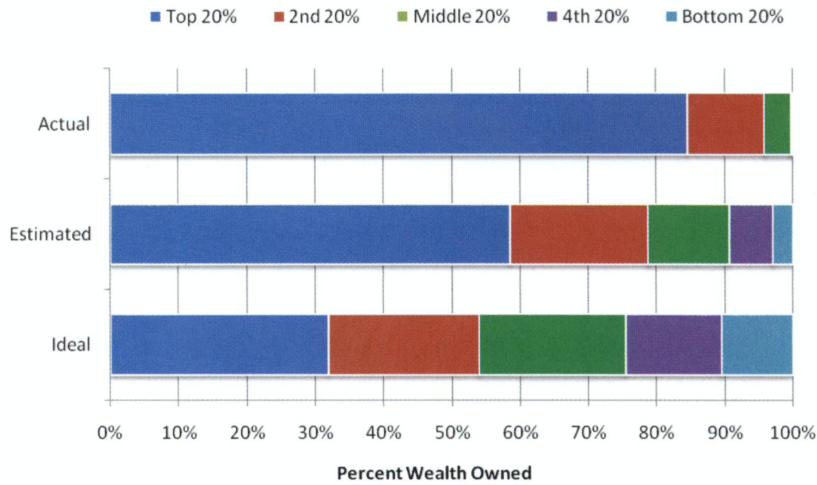It is a truism that “the first step to solving a problem is knowing it is there”. In my previous article, I described how rising inequality is associated with greater social and health issues. However, with a problem so mired in policy debates like inequality, it’s not enough for researchers to write papers on the subject. What do voters think? There is a growing consensus that the current gap between the rich and poor is problematic; according to Pew 61% of adults agree that there is “too much” inequality. So the public thinks there is too much, but do they understand just how much inequality there is?
A recent CBS report illustrated two important points about the way people handle information about inequality. As mall shoppers skirted around the journalist’s question, “Want to talk about wealth inequality?”, it was clear that most people would rather not think about the topic. Once lured in with the promise of pie and asked to divide America’s wealth among the different classes, it was also made clear that people don’t understand just how unequally sliced the American economy is.
Although the CBS reporter doesn’t mention it, his demonstration was a replication of a classic finding that people severely underestimate just how much inequality there is. In the original 2011 study, Harvard business professor Michael Norton and Duke psychologist Dan Ariely asked participants to estimate the actual wealth distribution in the U.S. and to propose an ideal wealth distribution. They found that people’s estimated and ideal wealth distributions were in stark contrast to the reality.

The richest 20% of the population has 84% of the 98 trillion dollars of wealth in the US, the next richest 20% own about 10% of the wealth, the middle 20% owns about 5%, and the bottom 40% of the population has less than 1% of the wealth. Taken from the 2011 paper, the figure above shows people’s estimation of the wealth distribution was far more equitable than the much bleaker reality and people’s ideal wealth distribution was relatively even more equitable (many people thought the bottom 20% of people should get 10% of the nation’s wealth, for example). Even more interesting is that people were generally in agreement across most demographics. Liberals, conservatives, rich, poor, men, and women all believed wealth was more equitable than in reality, and everybody thought the distribution of wealth should be even more equitable than it is currently. It seems that in this polarizing era, two things unite us: our preference for more equality and our ignorance of the scale of inequality.
Do people “know the problem is there?” People generally seem to be aware that there is too much inequality, probably in no small part due to discussion on the 2020 campaign trail. Despite this, we still underestimate how extreme inequality has become. Maybe this is because the statistical story about magnitude is just too difficult to communicate given that people are bad with large numbers. One question (of many) that remains: What will happen when our collective desire for equality is confronted with a collective realization of just how unequal things are?
Peer Edited by Melody Kessler
One Reply to “Inequality (Un)Awareness”